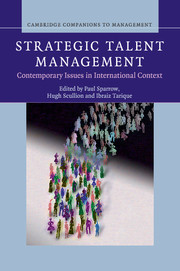Book contents
- Frontmatter
- Dedications
- Contents
- Figures
- Tables
- Contributors
- Foreword
- Acknowledgements
- Part I Mapping the field of strategic talent management
- Part II Redefining the boundaries of strategic talent management
- Part III Globalizing the strategic talent-management agenda
- 8 The strategic role of HR in the United States and China: relationships with HR outcomes and effects of management approaches
- 9 Emerging markets and regional patterns in talent management: the challenge of India and China
- 10 Globalizing the HR architecture: the challenges facing corporate HQ and international-mobility functions
- 11 Strategic talent management: future directions
- Index
- References
8 - The strategic role of HR in the United States and China: relationships with HR outcomes and effects of management approaches
Published online by Cambridge University Press: 05 July 2014
- Frontmatter
- Dedications
- Contents
- Figures
- Tables
- Contributors
- Foreword
- Acknowledgements
- Part I Mapping the field of strategic talent management
- Part II Redefining the boundaries of strategic talent management
- Part III Globalizing the strategic talent-management agenda
- 8 The strategic role of HR in the United States and China: relationships with HR outcomes and effects of management approaches
- 9 Emerging markets and regional patterns in talent management: the challenge of India and China
- 10 Globalizing the HR architecture: the challenges facing corporate HQ and international-mobility functions
- 11 Strategic talent management: future directions
- Index
- References
Summary
Introduction
The previous chapter laid out some of the developments in talent management when seen in a global context. In this chapter we look at the strategic context in the largest emerging market – that of China – through comparison of practices with those in the United States. Corporations in China and the United States differ greatly in many ways. United States’ firms typically are older and more global, thus it is not surprising that some research suggests that Chinese HRM policies and practices differ from Western HRM practices. In particular, there is evidence that HR functions allocate less time to strategic activities and play a less strategic role (Wei, 2010). However, there is some evidence of a two-speed system in China, whereby a small number of firms have highly sophisticated systems, while a much larger proportion has only very basic HR systems. This has been attributed to the difference between the relatively advanced management systems of large state-owned enterprises and the more basic systems characterizing smaller private firms.
The development of Chinese HRM has occurred in several phases (see Wei, 2010). During a Soviet-style traditional phase (from 1949 to 1979), there was little HR presence in organizations because much of HR management was dictated by state rules that required similar treatment across organizations, and with little worker movement across them (Naughton, 1996; Warner, 1996). This phase was followed by a reform phase (from 1979 to 1995), following the Third Plenary Session of the 11th Central Committee in late 1978. It allowed private ownership and foreign investment. It included greater profit incentive for enterprises, allowed for more experimentation with employment arrangements, and allowed the importation of HR practices by the Western firms that were investing in China (Wei, 2010).
- Type
- Chapter
- Information
- Strategic Talent ManagementContemporary Issues in International Context, pp. 197 - 223Publisher: Cambridge University PressPrint publication year: 2014

